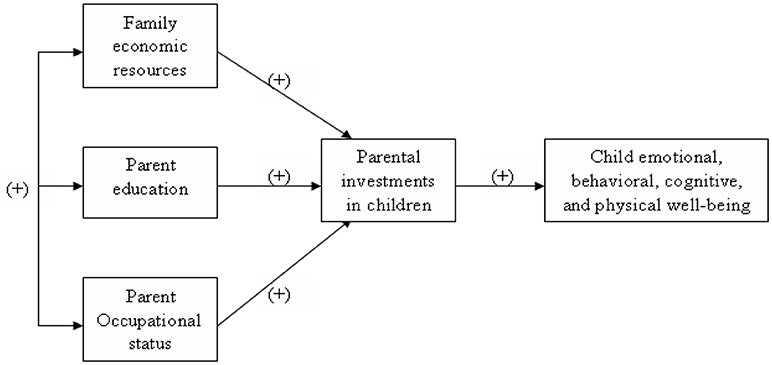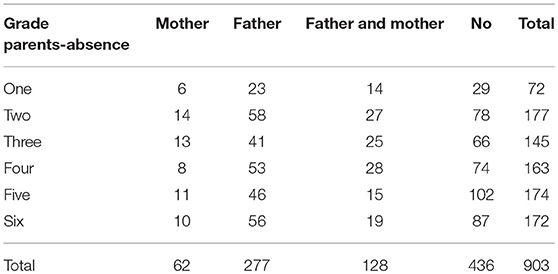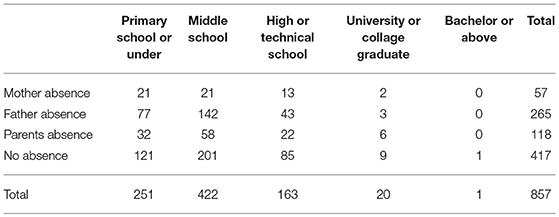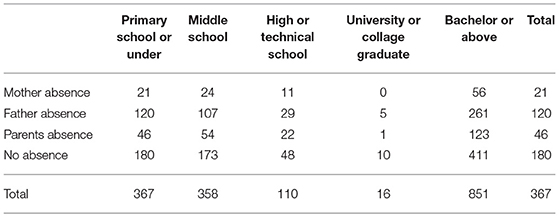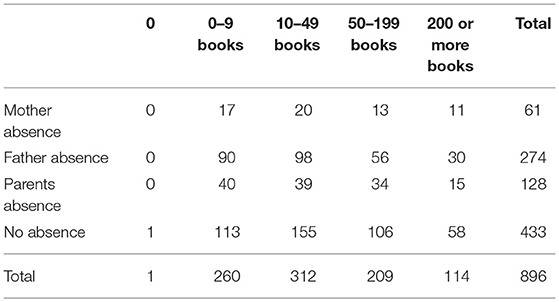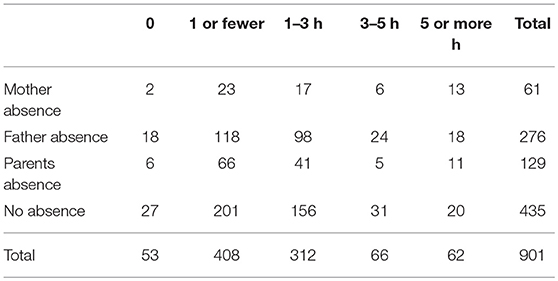- 1School of Psychology, Northwest Normal University, Lanzhou, China
- 2Key Laboratory of Behavioral and Mental Health of Gansu Province, Northwest Normal University, Lanzhou, China
Family environment affects children's reading comprehension ability. In poverty-stricken parts of rural China, some parents have been migrant workers for many years. It is common for left-behind children to have one or both parents permanently missing. This study explores the impact of parental absence on children's reading comprehension. We measured the reading comprehension of 903 children (467 left-behind and 436 parented), using the Chinese Primary School Students' Reading Comprehension Ability Scale. After controlling for the parents' levels of education, reading input, and interest variables, we found that children with absent parents had significantly lower reading comprehension scores than parented children; they struggled to understand chapter layout, the author's intentions, writing technique, evaluation, and appreciation. While children with absent fathers received the same scores as parented children, those with absent mothers received significantly lower scores. Clearly, absent mothers have a greater impact on children's reading comprehension than absent fathers.
Introduction
Reading is a necessary tool that enables individuals to learn about the outside world. The ability to read gives students a foundation for all types of study. It is also a basic skill that allows individuals to survive and develop (Smith et al., 2000). The ability to comprehend written text is a form of knowledge that integrates various complex skills (Torgesen, 2000).
The family investment model (see Figure 1) argues that parents with a higher socio-economic position are willing to invest more affection in their children. Such investments involve several different dimensions of family support, including: (a) learning materials available in the home; (b) parent stimulation of learning, both directly and by supporting advanced or specialized tutoring or training; (c) the family's standard of living (adequate food, housing, clothing, medical care); and (d) residing in a location that helps the child develop competencies (Conger and Donnellan, 2007). These factors are likely to have a positive effect on the child's academic performance and reading ability (Davis-Kean, 2005; Sohr-Preston et al., 2013).
In accordance with the family investment model, some studies have found that the family environment is one of the factors that affects children's reading ability (Noble et al., 2006). First, SES is a strong predictive factor for children's reading ability, and a correlation between high SES and a high reading level in experience related to children's reading (Noble et al., 2006). Children's development of language and literacy abilities and the scores in lower SES families are lower than those in high SES families (Leseman and De Jong, 1998). For example, compared with children in high SES families, children whose performances are lower in phonological awareness, letter naming, word writing, word recognition, receptive vocabulary and grammar etc. aspects (Aram and Levin, 2001). Besides, interactive dialogues in a shared-book reading process which is guided by the primary caregiver (generally, this is a role played by the mother) could enhance children's early language and literacy skills, and promote children's reading scores (Read et al., 2014). From a social constructivist view, children not only study the statements of books, they also learn from their communication with adults, language support from adults, and reading scaffolding during shared-book reading (Fletcher and Reese, 2005). Children positively construct their own knowledge system through discussion or raising questions during their reading process (Van Kleeck et al., 2015), and this process can not only improve children's literacy ability; it can also promote their social and emotional development. Second, (Briggs and Elkind, 1977) have suggested that the social position of parents may affect their children's reading ability. Differences in children's reading ability are often attributed to disparities in parents' levels of education (Scarborough and Dobrich, 1994). Moreover, researchers have found that parents who read with their children have an important impact on the development of their children's speech and reading ability (Morrow and Smith, 1990). Children's reading ability improves when their parents take part in reading activities (Whitehurst et al., 1994). Silinskas et al. (2012) has shown that the frequency of parental involvement in early childhood reading is positively related to children's reading ability; parental companionship in reading also fosters early reading ability. Relevant research has shown that, even when parents do not guide the formal reading or writing of young children, children who read with their parents and scribble graffiti at home start reading and writing very early. These activities foster children's ability to recognize the characters around them, leading to an interest in reading (Deng et al., 2015). Furthermore, a study of Chinese children has revealed that parental approaches to communication are another crucial element, affecting the development of children's speech. It is very beneficial for parents to join in with children's activities, respond to their speech, and stimulate them to speak, for example by explaining television programs or telling bedtime stories (Li, 2010). It has been confirmed that the way parents behave when interacting with and bringing up their children significantly affects the development of children's speech (Hoff, 2003).
Hoover and Gough (1990) proposed that simple reading view, which simplified the concept of reading as encoding and understanding, Encoding means word reading, which refers to the process of understanding basic word during reading. While reading is text reading, which refers to the understanding for the whole text construct and meaning based on understanding basic word during reading process. In the process of reading, understanding relays on basic encoding process, while the better encoding ability cannot present the ability of understanding is also good, because readers already had ability of understanding word, but they may lack ability of understanding whole text based on understanding word. Understanding is the main purpose of reading, many studies focused on effect of parent-child interaction on individuals' ability of encoding (Morrow and Smith, 1990; Scarborough and Dobrich, 1994; Hoff, 2003; Van Kleeck et al., 2015). In fact, parent-child interaction not only affects individuals' encoding ability of vocabulary, also affects ability of reading comprehension. Reading comprehension ability is a constructive thinking process, which not only includes an understanding of precious meaning, it also includes an understanding of implicit meaning. Reading comprehension ability includes understanding, application, analysis, comment and imagination, which means that various complex skills are integrated to result in the outcome (Torgesen, 2000). Anthony (2008) explored the extent of maternal responsiveness (descriptions, play, imitations) of infants (6, 12, and 24 months)and children in pre-school(3 and 4 years) and the predictive effect of children's cognitive skills on children's (aged 8) encoding and reading comprehension ability through a longitudinal study method. Results suggested that the extent of maternal responsiveness and children's cognitive ability could not predict children's (aged 8) encoding ability, regardless of whether they are term or preterm, while the extent of maternal responsiveness and children's (aged 4) cognitive ability could predict children's (aged 8) reading comprehension ability. Compared with children who demonstrate lower cognitive ability, there is a strong relation between responsive parents and later reading comprehension ability. Studies had found that the responsiveness of the mother can significantly predict children' spoken language development (Nicely et al., 1999); meanwhile, children's spoken language and reading comprehension abilities had a close relation (Catts and Weismer, 2006). Buil-Legaz et al. (2016) found that children's (aged 8) oral comprehension ability could markedly predict their performances on three tasks related to reading comprehension: a grammatical structures task, a sentence comprehension task and a text comprehension task.
In China, as urbanization has accelerated and a massive labor force has transferred to central areas, the population has declined sharply and a large number of children have been left behind in rural areas. Because one or both of their parents earn money in the city, the children, known as “left-behind children” (LBCs) are left in rural areas (Luo et al., 2009; Zhao and Shen, 2010). This concept was first introduced in the 1990s, referring to parents who went abroad to work or study, leaving their children to be cared for by a domestic worker (Kendrick and Marsh, 1997). This phenomenon has been prevalent in various parts of the world, including Japan (Carandang et al., 2007), the Philippines, (Reyes, 2007) and Mexico (Reyes, 2007; Tarroja and Fernando, 2013).
Compared with parented children, left-behind children rarely communicate with their parents, who are away for long periods of time. The language environment is monotonous, it is difficult to satisfy both the parents' and the children's communication needs through telephone conversations alone. In addition, absent parents seldom read with their children, which is likely to affect the development of the children's reading comprehension ability. However, no studies have focused on the effect of parental absence on the reading comprehension ability of children who have been left behind. The present study therefore explores the effect of parental absence on reading comprehension ability.
As mentioned above, several studies have found that the interaction between parents and children can affect the development of children's speech and reading. In addition, mothers play a crucial role in children's speech development (Tamis-Lemonda et al., 2001). The shared-book reading guided by the primary caregiver (usually the mother) has enhanced children's early language and literacy skills in the interactive conversation, which can promote children's reading performance (Read et al., 2014). Studies showed that if children were in a responsive affective-emotional climate, namely mother gave children warm, positive emotional supporting, and responded positively to children's questions during reading, then they would focus more on books, had a more positive reading experience, and actively cooperated with the mother's requirements, and finally these children read more frequently. The active participation of children in reading is more likely to promote early childhood language and literacy development than simply reading texts, while the praise and passion of the mother encourages children to participate in language expression in parent-child reading (Leseman and De Jong, 1998; Britto and Jeanne, 2006; Duursma, 2016). One study shows that the absence of one or both parents can have varying effects on children's academic performance, compared to an absent father, an absent mother has a much more significant impact on children's academic performance (Fu et al., 2017). We therefore hypothesize that: (1) the reading comprehension ability of left-behind children is worse than that of parented children because the left-behind children are missing one or both parents for a long period of time; (2) an absent mother has a greater impact than an absent father on children's reading comprehension ability.
Method
Participants
In this study, we selected a total of 903 children in grades 1–6 (see Table 1), from the basic education program of OxfamHongkong education founding, the intervention study of left-behind children's reading in rural, impoverished areas in Gansu province, and five primary schools in the same rural area in Longxi county in Gansu province. The data provided by the local education department showed that left-behind children comprised over 50% of the student population in these five schools. In addition, the five schools in this study are village primary schools, and the teachers have an equivalent educational background and communicate with each other regarding their teaching process, approach to student questions, and ensure consistency in teaching content, student progress, and methods, based on the requirements of the local educational department. The group included 436 parented children (204 girls, 46.79%; 232 boys, 53.21%) and 467 left-behind children (235 girls, 50.32%; 232 boys, 49.68%). Of the left-behind children, 62 had absent mothers and were cared for by their fathers, 277 had absent fathers and were cared for by their mothers, and 128 had two absent parents. The intelligence of four groups of children was assessed and found to be normal, based on teachers' reports; we did not find any instances of an intelligence defect or disorder among the study participants (for details, see Appendix).
There was no significant difference in sex distribution between the left-behind and parented children, χ2(1) = 1.13, p = 0.29. The main effect of the four groups' age is not significant, F(3, 899) = 1.496, p = 0.214. We also fail to find significant differences between children's age with an absent mother (M = 9.6, SD = 1.52) an absent father (M = 9.93, SD = 1.72), between parents absence (M = 9.97, SD = 1.40) and non-left-behind children (M = 10.04, SD = 1.46).
Participation in the study was entirely voluntary. Written informed consent was obtained from the children's parents before the children were enrolled in our study. This study has been reviewed and approved by the scientific and research Ethical Committee of the School of Psychology, Northwest Normal University.
Research Tools
Basic Family Situation Survey
This survey provided information on the demographic status of the children, including their age, grade, gender and parental level of education (fathers' and mothers' educational attainment), family possessions, and siblings. The following question was used to ask participants about the location of their parents: In the past 6 months, have you been living with your parents?
A. I have been living with both my mom and dad;
B. I have been living with my mom, while my dad is away from home;
C. I have been living with my dad, while my mom is away from home;
D. My mom and dad don't live with me.
Participants answered this question to determine their status as parented children (both parents at home), children with an absent father (mother at home, father away), children with an absent mother (mother away, father at home), or children with both parents away.
Reading Status Questionnaire
This questionnaire was used to assess the number of children's books in the home, extracurricular reading hours, and reading interests. The reading interest questionnaire drew on a study by Hidi (2001), who examined students' perceived interest in reading activities and reading objects. The questionnaire had a total of 8 questions, rated using a 5-point Likert scale. In the present study, the internal consistency coefficient for this set of scales was 0.74.
Reading Comprehension Test
The Chinese scholar Wen (2005) designed a primary school Chinese reading comprehension ability test, divided into three sections for the lower, middle, and senior grades; each scale consists of four short essays. Students in grades 1–2 used the lower-grade scale, answering 32 questions after each essay; students in grades 3–4 used the middle-grade scale, with 48 questions; students in grades 5–6 used the upper-grade scale, with 52 questions. The three test questions covered eight dimensions, including micro-level reading comprehension (understanding words, phrases, context, and coherence), macro-level reading comprehension (understanding chapter layout, the author's writing intention and expressive techniques, important information, corollaries of potential information, the organization and construction of information overall, and reading-level evaluation (evaluation and appreciation). The tool had good reliability and validity (Wen, 2005). In the present study, the internal consistency coefficient for this set of scales was 0.86 for grades 1–2, 0.72 for grades 3–4, and 0.67 for grades 5–6.
Research Procedure
In this study, the tests were conducted in classes of approximately 30 students. The survey was administered by trained experimenters and 2–3 teachers as assistants and the assessment administered by the whole class in this study.
Research Results
First, an independent sample t-test was carried out to determine the reading comprehension scores of parented children (M = 19.33, SD = 7.75) and left-behind (M = 18.29, SD = 7.69) The scores of left-behind children were significantly lower than those of parented children, t(901) = −2.03, p = 0.04, d = 0.13.
Second, an analysis of covariance was used to further explore the impact of different types of parental absence on the reading comprehension of left-behind and parented children. When we controlled for the following variables—the mother's educational level, the father's educational level, family book ownership, and daily reading time and interest—the slope of these variables was homogeneous. The evidence suggests that the main effect of the father's education level is not significant, F(1, 833) = 0.010, p = 0.921, η2 = 0.001; the main effect of the mother's education level is not significant, F(1, 833) = 0.131, p = 0.717, η2 = 0.001; the main effect of the household collection of books is not significant, F(1, 833) = 1.64, p = 0.685, η2 = 0.001; the main effect of outside reading time is not significant, F(1, 833) = 0.002, p = 0.961, η2 = 0.001; and the main effect of reading interest is also not significant, F(1, 833) = 1.555, p = 0.213, η2 = 0.002; the main effect of parental absence was significant, F(3, 833) = 3.057, p = 0.028, η2 = 0.01(see Figure 2). A further analysis suggested that the reading comprehension scores of parented children (M = 19.33, SD = 7.52) were significantly higher than those of children with absent mothers (M = 17.10, SD = 7.64) or absent parents (M = 17.43, SD = 7.53), ps < 0.05 , d = 0.29, d = 0.25. There were no significant differences between parented children (M = 19.33, SD = 7.52) and children with absent fathers (M = 18.95, SD = 7.73), when it came to reading comprehension, p > 0.05, d = 0.05. There were no significant reading comprehension differences between children with absent mothers (M = 17.10, SD = 7.73) and those with absent parents (M = 17.43, SD = 7.53), p > 0.05, d = 0.02.
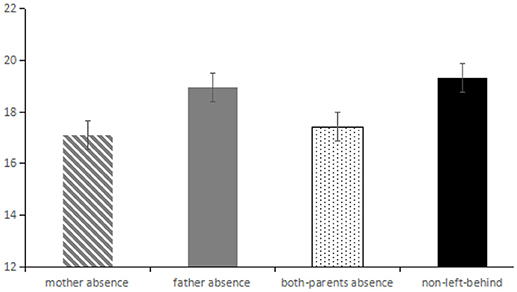
Figure 2. The reading comprehension scores of children with absent mothers, absent fathers, and absent parents as well as parented children.
In addition, the interaction between parental absence and covariates was tested within the ANOVA-based models, the results show that the interaction between parental absence and father's education level were not significant, F(4, 882) = 0.555, p = 0.695, η2 = 0.003; the interaction between parental absence and mother's education level were not significant, F(4, 882) = 0.162, p = 0.958, η2 = 0.001; the interaction between parental absence and family book ownership were not significant, F(4, 882) = 0.620, p = 0.648, η2 = 0.003; the interaction between parental absence and daily reading time were not significant, F(4, 882) = 1.342, p = 0.253, η2 = 0.006; the interaction between parental absence and reading interest were not significant, F(4,882) = 1.620, p = 0.167, η2 = 0.007.
A final analysis of covariance showed that the slopes were the same when the mother's educational level, father's educational level, family book collection, and daily reading time and interests were used as control variables. The eight dimensions of reading comprehension—understanding context, coherent reasoning, understanding the layout of the text, the author's writing intention, grasping key information, inferring potential information, organizing and constructing overall information, and evaluating and appreciating the text—were used to further analyze differences in the reading comprehension ability of parented and left-behind children. The results are shown below, in Table 2.

Table 2. The main effect of dimensionalities on parental absence status in the reading comprehension ability.
The results reveal no significant differences related to parental absence in the two dimensions of microcosmic reading comprehension, F(3, 894) = 1.66, F(3, 894) = 0.171, pS > 0.05. Parental absence had a significant impact on structural reading, within macroscopic reading comprehension, F(3, 894) = 4.79, p < 0.05, η2 = 0.02. Parental absence did not have a significant impact on informational reading, within macroscopic reading comprehension. This set of skills included grasping key information, F(3, 894) = 0.739, p > 0.05, η2 = 0.02; the corollary of potential information, F(3, 894) = 1.895, p > 0.05, η2 = 0.006; and organizing and constructing overall information, F(3, 894) = 1.178, p > 0.05, η2 = 0.004. On the evaluation reading level, the main effect was significant, F(3, 894) = 2.6, p = 0.051, η2 = 0.009.
Furthermore, the main effect of the three major dimensions (understanding chapter layout, the author's writing intention and expressive technique, evaluation and appreciation) was significant, as Figures 3–5 make clear.
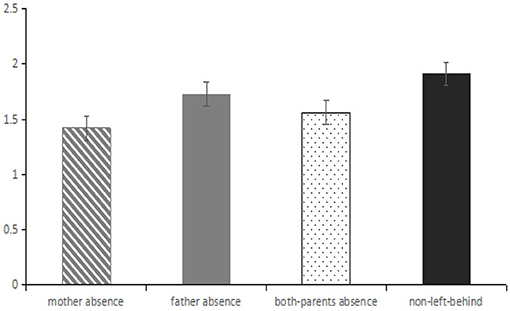
Figure 3. The scores of children with absent mothers, absent fathers, absent parents, and both parents present for comprehending the layout of a chapter.
Figure 3 shows that parented children received significantly higher scores for understanding chapter layout (M = 1.91, SD = 1.29) than children with absent mothers (M = 1.42, SD = 1.11) or absent parents (M = 1.56, SD = 1.21), ps < 0.05,d = 0.41, d = 0.28. There were no significant differences between parented children (M = 1.93, SD = 1.52) and children with absent fathers (M = 1.73, SD = 1.23), p > 0.05, d = 0.14. when it came to understanding the layout of chapters. There were also no significant differences between children with absent mothers (M = 1.42, SD = 1.11) and children with absent parents at that level (M = 1.56, SD = 1.21), p > 0.05, d = 0.12.
Figure 4 shows that the scores of parented children (M = 2.51, SD = 1.74) were significantly high than those of children with absent parents (M = 2.07, SD = 1.61) when it came to understanding the author's writing intention and expressive technique, p < 0.05, d = 0.26. There was no significant difference between the scores of parented children (M = 2.51, SD = 1.74) and children with absent mothers (M = 2.27, SD = 1.69) when it came to the author's writing intention and expressive technique, p > 0.05, d = 0.14. There was likewise no significant difference between the scores of parented children (M = 2.52, SD = 1.74) children with absent fathers (M = 2.51, SD = 1.78), p > 0.05, d = 0.01. In this range of competencies, there were no significant differences between children with absent mothers (M = 2.27, SD = 1.69) and those with absent parents (M = 2.07, SD = 1.61), p > 0.05, d = 0.06.
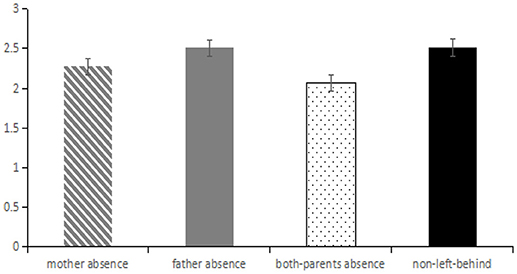
Figure 4. The ability to understand an author's writing intention and expressive technique among children with absent mothers, absent fathers, absent parents, and both parents present.
Figure 5 reveals that the differences between the evaluation and appreciation scores of parented children (M = 2.24, SD = 1.57) and those with absent mothers (M = 1.95, SD = 1.57) were marginally significant, p = 0.06, d = 0.18. The scores of parented children (M = 2.24, SD = 1.57) were higher than those of children with absent mothers (M = 1.99, SD = 1.47), p < 0.05, d = 0.16. In the area of evaluation and appreciation, there were no significant differences between parented children (M = 2.24, SD = 1.57) and those with absent fathers (M = 2.26, SD = 1.49), P > 0.05, d = 0.01. There were no significant differences between children with missing mothers (M = 1.95, SD = 1.57) and those with missing parents (M = 1.99, SD = 1.47), p > 0.05, d = 0.03.
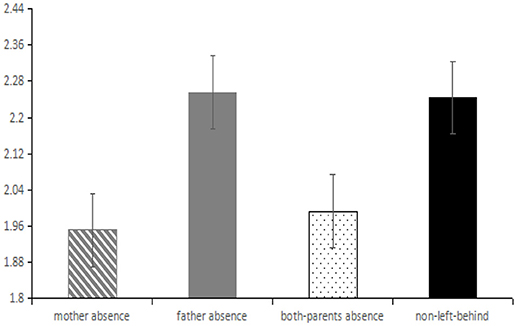
Figure 5. The scores of children with absent mothers, absent fathers, absent parents, and both parents present in relation to evaluation and appreciation.
Discussion
Children in grades 1–6 grade in rural primary schools participated in the present study. We used the Reading Comprehension Test (Wen, 2005) to evaluate the reading comprehension of left-behind children, including those with missing mothers, fathers, and parents; the aim of this study was to explore the effect of parental absence on children's reading comprehension ability.
After controlling for gender, the educational level of parents, and reading investment and interest variables, the result suggested that left-behind children had much lower scores for reading comprehension ability than parented children. First of all, the family economic levels of left-behind children is lower than non-left-behind children, which may cause different reading ideas, which further affect children's reading comprehension ability. For example, low-income and low-educated parents consider that the purpose of reading is about to become literate and acquire knowledge, on the contrary, high-educated mothers pay more attention to children's degree of involvement in reading, because they believe that it is more worthy of paying attention to children's degree of involvement in reading and dialogue with adults, and the latter means deep understanding of texts (Justice, 2008). Compared with middle-class mothers, low-income mothers give children more instructions in the reading process, and there are few instructive behaviors for children, their conversations and discussion of topics in reading process are very rare (Ninio, 1980). Moreover, high SES mothers are more detailed and affirmative about a topic, while low SES mothers lead less talk, and often talk about multiple topics in a conversation with their children, which means that high SES mothers can talk about a topic more deep, while the guidance of low SES mothers is more casual and shallow (Hoff, 2003; Lai, 2010), which have negative impact on the development of children's reading comprehension.
Our result proved that parental absence had an impact on children's reading comprehension ability. This conclusion was in line with previous studies, one of which found that parents who took part in their children's academic activities could produce a distinct effect on the children's academic performance (Jeynes, 2015). In pre-school, parents also played an important role, at the stage when the children's oral language was being transferred to written language (Laakso et al., 2004; Aram and Levin, 2011). Parents and children reading together could promote the development of children's literacy (Whitehurst et al., 1994; Sénéchal et al., 1996, 1998; Frijters et al., 2000). In addition, parent-child reading is a pattern; when parents and children are encouraged to read together and children are invited to immerse themselves in storytelling, children's reading motivation is strengthened (Topping, 1987). Left-behind children lacked effective supervision, encouragement, and interaction with parents; as a result, their reading comprehension ability was weaker than that of parented children.
Moreover, our study found that left-behind children with absent mothers or parents had the lowest scores, while parented children and those with absent fathers had very similar scores. It is clear that an absent mother has a more important impact on children's reading. In other words, the mother is a pivotal part of the development of children's reading comprehension ability. This result was also consistent with previous studies. Generally, mothers participate more in their children's education than fathers do (Kim and Hill, 2015). Mothers with an intimate approach and positive attitude can significantly help their children by participating in their education and upbringing (Parke, 2002; Lareau, 2003; Lamb, 2010). Other studies have shown that this approach benefits children's academic development (Levin et al., 1997; Rogers et al., 2009). It is clear that mothers play an important role in their children's education, when they get involved with their children's daily lives and educational activities. Especially during the primary school years, mother can become directly involved in their children's education, for instance, by helping their children finish homework, and joining in school activities (Parke, 2002; Lamb, 2010). Furthermore, the attachment between mother and child has an impact on children's interest in reading. Bus and van Ijzendoorn (1988) conducted a study on the relationship between the quality of parent-child attachment and reading skills and interests among pre-school children. They found that children with a safe attachment relationship needed less training and fewer rules, read more easily, and were less distracted and upset than children with an unsafe attachment pattern. If children with normal intelligence had an unsafe attachment to their mothers, reading would be delayed. By contrast, in a safe attachment pattern, the mother would guide the child's reading and spend more time reading to the child. This is a key reason for the impact of maternal absence on children's reading comprehension ability.
Another important finding was that maternal absence had a much more significant impact on children's reading comprehension ability in the advanced levels. According to Kintsch (1988, 1998) and Wen (2005), text comprehension is a “bottom-up” activity, from microcosmic article reading comprehension to macroscopic article reading comprehension and appreciative reading. We did not find a significant difference between parented children and left-behind children with one or two absent parents when it came to microcosmic article reading comprehension. In the assessment of macroscopic article reading comprehension (understanding writing structure, and the author's writing intention and expressive technique), the scores were much lower in children with absent parents and mothers, than in parented children. In appreciative reading, children with absent parents had much worse scores than parented children.
Heath (1982) found that mothers used three approaches to asking questions when reading with children. The first approach involved “what-explaining:” asking basic reading comprehension questions to help the child understand an event or the main concept in a story. The second approach involved “reason-explaining:” asking the child to explain why an event might have happened or why a protagonist would engage in particular behaviors. These questions can help the child understand causality in a story. The third approach involved “affective comments:” the mother asked the child to comment on particular figures or events, and to say whether the characters' behavior was right or wrong, clever or foolish. In addition, Minami (1999) has identified three patterns for mothers and children reading picture books together: (1) the “fill the blank: pattern—depending on the content of the story, the mother would ask some questions and expect the child tell her answers. (2) The three-step pattern—the mother will introduce a topic using questions; the child responds; finally, the mother provides feedback. This pattern is a typical classroom interaction model. (3) This pattern is a modified version of the trigger-response-comment pattern. First of all, the mother asks some questions about one topic, followed by the child's response. The mother then gives feedback. These studies have also suggested that the mother-child interaction model and strategy could affect children's advanced reading comprehension ability, including the ability to understand the structure of writing, such as the genre of an article, the thread of an argument, and the layers of structure. Comment and appreciation mainly related to the article's form of language and content viewpoint. Importantly, the present study has found that the effect of maternal absence on children's reading most seriously affects children of advanced reading comprehension ability.
Limitations and Future Directions
To further determine the relation between parental absence and poor reading comprehension, more strict control for irrelevant variables is needed. In this study, we tried to ensure that each group was matched in terms of domestic economy income, parents' education levels, family collection of books, reading time each day and reading interests, etc., but we did not conduct strict matching for parenting styles, present stresses and mental health to ensure that this study had optimal ecological validity; future studies could implement measures that maintain stricter control over irrelevant variables to strengthen the reliability of the study.
Additionally, we did not determine the features of development for the effect of parents' absence on children's reading comprehension; for example, the age at which parental absence has a more significant effect on reading comprehension ability and the extent to which school education can make up for the effect of a parent's absence on children's reading comprehension ability are both still unknown. Future studies should further expand sample size to explore this question from a developmental view.
Further, we mainly explored the effect of parental absence on children's reading comprehension ability, and results suggested that parental absence likely affects children's advanced reading comprehension ability, but the specific ways in which parental absence influences children's advanced reading comprehension ability, whether parental absence affects some literacy-related skills such that children's advanced reading comprehension is indirectly influenced, and whether there are moderating variables such as reading material types, are all questions that need further exploration and investigation.
Implications for Education
Compared with non-left-behind-children, left-behind-children had low levels of ability with regard to reading comprehension, which predominantly showed in children whose mother was absent, because mothers spend more time interacting with their children, undertake more tasks related to raising children, and are generally the main support for shared-book reading. The absence of the mother causes a decrease in the likelihood or instances of parent-child reading, resulting in a decrease in children's performance in advanced reading comprehension tasks.
There are several implications from the results of this study that have practical applications. First, the mother plays a crucial role in the development of children's reading comprehension ability. For left-behind children with lower SES, although poverty posed a threat to their development, its negative effect is minimized from material restriction if their parents successfully provide a stable environment which is beneficial to their emotional and cognitive development. In this study, there were no significant differences between left-behind children with an absent father and non-left-behind children with higher SES, which supports the above view. In addition, as mothers are the most important source of support during children's growth and development, they should avoid being absent, and they may devise other approaches to maintain parent-child communication and reading together, even though they cannot be present with their children. For example, they can communicate with their children and give reading guidance to their children via the Internet and they can provide positive responses to their children's questions online, which is beneficial for their child's reading experience and reading comprehension ability may be improved when children positively cooperative with their mothers' requirements. Besides, the effect of the mother on children's reading comprehension ability was primarily evident on the advanced reading comprehension level; the mother should learn more about effective guidance methods related to shared-book reading and train their children to use dialogue or an interaction model during shared-book reading. For instance, expanding children's language expression through open questions and design, paying attention to their comprehension of the story plot in books, connecting the story with the children's experience, and encouraging children to communicate without context will improve children's reasoning, prediction, and conversational abilities. Moreover, school is a place where children acquire education, and teachers also play important roles in children's development; teachers should focus on the effect of SES on children's development in school, and directly provide left-behind children with educational measures and a customized education project as a form of intervention, while also focusing on their study and reading participation to further reduce the risk of a reading disorder in left-behind children, especially in those children whose mother is absent.
Conclusion
Parental absence affects children's reading comprehension ability. An absent mother has a more significant impact than an absent father, as principally reflected in children with advanced reading comprehension ability.
Author Contributions
MX: study design; DW: data collection and analysis; ZA: preparation of the manuscript.
Funding
This work was supported by grants to MX by the National Natural Science Foundation of China (31860282) and the Education of Humanities and Social Science Research on Youth Fund Project (15YJC190015).
Conflict of Interest Statement
The authors declare that the research was conducted in the absence of any commercial or financial relationships that could be construed as a potential conflict of interest.
References
Anthony, J. L. (2008). The interaction of early maternal responsiveness and children's cognitive abilities on later decoding and reading comprehension skills. Early Educ. Dev. 19, 188–207. doi: 10.1080/10409280701839304
Aram, D., and Levin, I. (2001). Mother-child joint writing in low SES: Sociocultural factors, maternal mediation, and emergent literacy. Cognit. Dev. 16, 831–852. doi: 10.1016/S0885-2014(01)00067-3
Aram, D., and Levin, I. (2011). “Home support of children in the writing process: contributions to early literacy” in Book: Handbook of early literacy, eds S. Neuman and D. Dickinson(Newyork, NY: Guilford) 189–199.
Briggs, C., and Elkind, D. (1977). Characteristics of early readers. Percept. Motor Skills 44, 1231–1237. doi: 10.2466/pms.1977.44.3c.1231
Britto, P. R., and Jeanne, B. G. (2006). Maternal reading and teaching patterns: associations with school readiness in low-income african american families (lectura materna y patrones de enseñanza: asociaciones con la preparación para la escuela en familias afro-americanas de bajos recursos). Reading Res. Q. 41, 68–89. doi: 10.1598/RRQ.41.1.3
Buil-Legaz, L., Aguilar-Mediavilla, E., and Rodríguez-Ferreiro, J. (2016). Oral morphosyntactic competence as a predictor of reading comprehension in children with specific language impairment. Int. J. Lang. Commun. Disord. 51, 473–477. doi: 10.1111/1460-6984.12217
Bus, A. G., and van Ijzendoorn, M. H. (1988). Attachment and early reading: a longitudinal study. J. Genet. Psychol. 149, 199–210. doi: 10.1080/00221325.1988.10532153
Carandang, M. L. A., Sison, B. A., and Carandang, C. (2007). Nawala Ang Ilaw Ng Tahanan:Case Studies Of Families Left Behind By Ofw Mothers. Pasig City: Anvil Publishing.
Catts, H., and Weismer, S. E. (2006). Language deficits in poor comprehenders: a case for the simple view of reading. J. Speech Lang. Hearing Res. 49, 278–293. doi: 10.1044/1092-4388(2006/023)
Conger, R. D., and Donnellan, M. B. (2007). An interactionist perspective on the socioeconomic context of human development. Soc. Sci. 58, 175–199. doi: 10.1146/annurev.psych.58.110405.085551
Davis-Kean, P. E. (2005). The influence of parent education and family income on child achievement: the indirect role of parental expectations and the home environment. J Fam Psychol. 19, 294–304. doi: 10.1037/0893-3200.19.2.294
Deng, C., Silinskas, G., Wei, W., and Georgiou, G. K. (2015). Cross-lagged relationships between home learning environment and academic achievement in Chinese. Early Child. Res. Q. 33, 12–20. doi: 10.1016/j.ecresq.2015.05.001
Duursma, E. (2016). Who does the reading, who the talking? low-income fathers and mothers in the us interacting with their young children around a picture book. First Lang36, 465–484. doi: 10.1177/0142723716648849
Fletcher, K. L., and Reese, E. (2005). Picture book reading with young children: a conceptual framework. Dev. Rev. 25, 64–103. doi: 10.1016/j.dr.2004.08.009
Frijters, J. C., Barron, R. W., and Brunello, M. (2000). Direct and mediated influences of home literacy and literacy interest on prereaders' oral vocabulary and early written language skill. J. Educ. Psychol. 92, 466–477. doi: 10.1037/0022-0663.92.3.466
Fu, M., Bo, W. V., Xue, Y., and Yuan, T. F. (2017). Parental absence accompanies worse academic achievements: evidence based upon a sample of left-behind children in rural china. Front. Educ. 2:38. doi: 10.3389/feduc.2017.00038
Heath, B. S (1982). What no bedtime story means: narrative skills at home and school. Lang. Soc. 11, 49–76. doi: 10.1017/S0047404500009039
Hidi, S. (2001). Interest, reading, and learning: theoretical and practical considerations. Edu. Psychol. Rev. 13, 191–209. doi: 10.1023/A:1016667621114
Hoff, E. (2003). The specificity of environmental influence: socioeconomic status affects early vocabulary development via maternal speech. Child Dev. 74, 1368–1378. doi: 10.1111/1467-8624.00612
Hoover, W. A., and Gough, P. B. (1990). The simple view of reading. Reading Writing 2, 127–160. doi: 10.1007/BF00401799
Jeynes, W. H. (2015). A meta-analysis: the relationship between father involvement and student academic achievement. Urban Educ. 50, 638–641. doi: 10.1177/0042085914525789
Justice, L. M. (2008). Relations among maternal literacy beliefs, home literacy practices, and the emergent literacy skills of preschoolers with specific language impairment. Early Educ. Dev. 19, 68–88. doi: 10.1080/10409280701839015
Kendrick, D., and Marsh, P. (1997). Injury prevention programmers in primary care: a high risk group or a whole population approach? Inj. Prev. 3:170. doi: 10.1136/ip.3.3.170
Kim, S. W., and Hill, N. E. (2015). Including fathers in the picture: a meta-analysis of parental involvement and students' academic achievement. J. Educ. Psychol. 107, 919–934. doi: 10.1037/edu0000023
Kintsch, W. (1988). The role of knowledge in discourse comprehension: a construction-integration model. Psychol. Rev. 95:163. doi: 10.1037/0033-295X.95.2.163
Kintsch, W. (1998). Comprehension: A Paradigm for Cognition. New York, NY: Cambridge University Press.
Laakso, M. L., Poikkeus, A. M., Eklund, K., and Lyytinen, P. (2004). Interest in early shared reading: its relation to later language and letter knowledge in children with and without risk for reading difficulties. First Lang. 24, 323–345. doi: 10.1177/0142723704046041
Lai, W.-F. (2010). ‘Talking like a book?’ socioeconomic differences of maternal conversational styles in co-constructing personal narratives with young Taiwanese children. Early Child Dev. Care 180, 1361–1377. doi: 10.1080/03004430903083433
Lareau, A. (2003). Unequal Childhoods: Class, Race, and Family Life. Berkeley, CA: University of California Press.
Leseman, P. P. M., and De Jong, P. F. (1998). Home literacy: opportunity, instruction, cooperation and social-emotional quality predicting early reading achievement. Read. Res. Q. 33, 294–318. doi: 10.1598/RRQ.33.3.3
Levin, I., Levy-Shiff, R., Appelbaum-Peled, T., Katz, I., Komar, M., and Meiran, N. (1997). Antecedents and consequences of maternal involvement in children's homework: a longitudinal analysis. J. Appl. Dev. Psychol. 18, 207–227. doi: 10.1016/S0193-3973(97)90036-8
Li, X. Y. (2010). A comparative study on vocabulary of chinese mothers of different educational background in interacting with their young children. Stud. Preschool Educ. 42–47 (in Chinese).
Luo, J., Wang, W., and Gao, W. B. (2009). Review of the studies on rural left-behind children in China. Adv. Psychol. Sci. 17, 990–995.
Minami, M. (1999). Styles of parent-child book-reading in japanese families. Asian Americans 33, 1–33.
Morrow, L. M., and Smith, J. K. (1990). The effects of group size on interactive storybook reading. Reading Res. Q. 25, 213–231. doi: 10.2307/748003
Nicely, P., Tamis-Lemonda, C. S., and Bornstein, M. H. (1999). Mothers' attuned responses to infant affect expressivity promote earlier achievement of language milestones. Infant Behav. Dev. 22, 557–568. doi: 10.1016/S0163-6383(00)00023-0
Ninio, A. (1980). Picture-book reading in mother-infant dyads belonging to two subgroups in Israel. Child Dev. 51, 587–590. doi: 10.2307/1129299
Noble, K. G., Farah, M. J., and McCandliss, B. D. (2006). Socioeconomic background modulates cognition–achievement relationships in reading. Cog Dev. 21, 349–368. doi: 10.1016/j.cogdev.2006.01.007
Parke, R. D. (2002). “Fathers and families,” in Handbook of Parenting: Being and Becoming a Parent, ed M. H. Bornstein (Mahwah: Lawrence Erlbaum Associates), 27–73.
Read, K., Macauley, M., and Furay, E. (2014). The seuss boost: rhyme helps children retain words from shared storybook reading. First Language 34, 354–371. doi: 10.1177/0142723714544410
Rogers, M. A., Theule, J., Ryan, B. A, Adams, G. R, and Keating, L. (2009). Parental involvement and children's school achievement: evidence for mediating processes. Can. J. School Psychol. 24, 34–57. doi: 10.1177/0829573508328445
Scarborough, H. S., and Dobrich, W. (1994). On the efficacy of reading to preschool. Dev. Rev. 14, 245–302. doi: 10.1006/drev.1994.1010
Sénéchal, M., Lefevre, J. A., Hudson, E., and Lawson, E. P. (1996). Knowledge of storybooks as a predictor of young children's vocabulary. J. Edu. Psychol. 88, 520–536. doi: 10.1037/0022-0663.88.3.520
Sénéchal, M., Lefevre, J. A., Thomas, E. M., and Daley, K. E. (1998). Differential effects of home literacy experiences on the development of oral and written language. Reading Res. Q. 33, 96–116. doi: 10.1598/RRQ.33.1.5
Silinskas, G., Lerkkanen, M. K., Tolvanen, A., Niemi, P., Poikkeus, A. M., and Nurmi, J. E. (2012). The frequency of parents' reading-related activities at home and children's reading skills during kindergarten and grade 1. J. Appl. Dev. Psychol. 33, 302–310. doi: 10.1016/j.appdev.2012.07.004
Smith, M. C., Mikulecky, L., Kibby, M. W., Dreher, M. J., and Dole, J. A. (2000). What will be the demands of literacy in the workplace in the next millennium? Reading Res. Q. 35, 378–383. doi: 10.1598/RRQ.35.3.3
Sohr-Preston, S. L., Scaramella, L. V., Martin, M. J., Neppl, T. K., Ontai, L., and Conger, R. (2013).
Tamis-Lemonda, C. S., Bornstein, M. H., and Baumwell, L. (2001). Maternal responsiveness and children's achievement of language milestones. Child Dev. 72, 748–767. doi: 10.1111/1467-8624.00313
Tarroja, M. C. H., and Fernando, K. C. (2013). Providing psychological services for children of overseas Filipino workers (OFWs): a challenge for school psychologists in the Philippines. Sch. Psychol. Int. 34, 202–212. doi: 10.1177/0143034312453399
Topping, K. (1987). Paired reading: a powerful technique for parent use. Reading Teacher 40, 608–614.
Torgesen, J. K. (2000). Individual differences in response to early interventions in reading: the lingering problem of treatment resisters. Learn. Disabil. Res. Prac. 15, 55–64. doi: 10.1207/SLDRP15016
Van Kleeck, A., Stahl, S. A., and Bauer, E. B. (2015). On reading books to children: parents and teachers. Educ. Health 29, 529–530.
Wen, H. (2005). Primary Chinese Reading Ability Scales:Valibity and Reliability. Doctoral dissertation, South China Normal University.
Whitehurst, G. J., Epstein, J. N., Angell, A. L., Payne, A. C., Crone, D. A., and Fischel, J. E. (1994). Outcomes of an emergent literacy intervention in head start. J. Edu. Psychol. 86, 542–555. doi: 10.1037/0022-0663.86.4.542
Zhao, J. X., and Shen, J. L. (2010). The effect of pre-study or post-study emotional arousal on implicit and explicit memory. Chinese J. Spec. Edu. 7, 65–70.
Appendix
Keywords: left-behind children, reading comprehension, parental absence, family environment, SES
Citation: Xiaofeng M, Wenhui D and Aibao Z (2018) The Link Between Parental Absence and Poor Reading Comprehension: Evidence From the Left-Behind Children in Rural China. Front. Educ. 3:71. doi: 10.3389/feduc.2018.00071
Received: 12 March 2018; Accepted: 09 August 2018;
Published: 10 September 2018.
Edited by:
Jason C. Immekus, University of Louisville, United StatesReviewed by:
Duo Liu, The Education University of Hong Kong, Hong KongEmmanouela Terlektsi, University of Birmingham, United Kingdom
Copyright © 2018 Xiaofeng, Wenhui and Aibao. This is an open-access article distributed under the terms of the Creative Commons Attribution License (CC BY). The use, distribution or reproduction in other forums is permitted, provided the original author(s) and the copyright owner(s) are credited and that the original publication in this journal is cited, in accordance with accepted academic practice. No use, distribution or reproduction is permitted which does not comply with these terms.
*Correspondence: Ma Xiaofeng, cHN5bWF4aWFvZmVuZ0AxMjYuY29t
Zhou Aibao, WmhvdWFiQG53bnUuZWR1LmM=
 Ma Xiaofeng
Ma Xiaofeng Deng Wenhui1,2
Deng Wenhui1,2